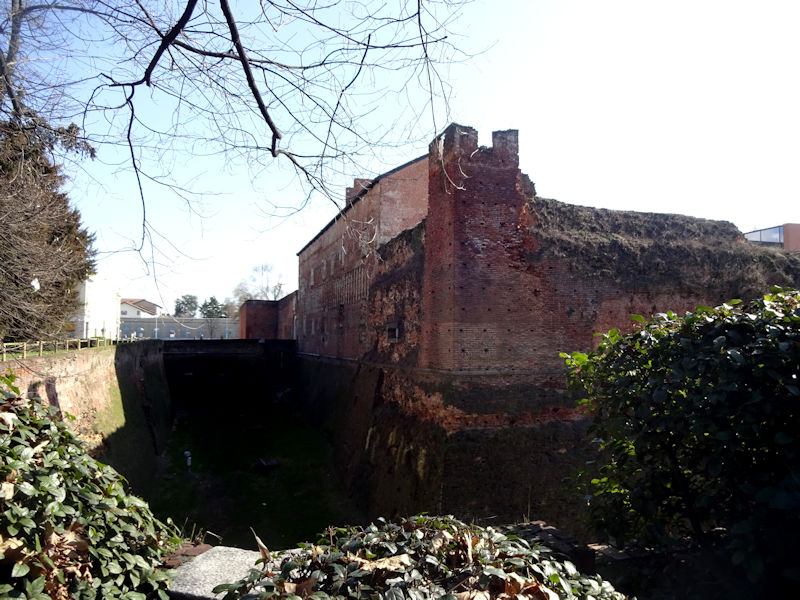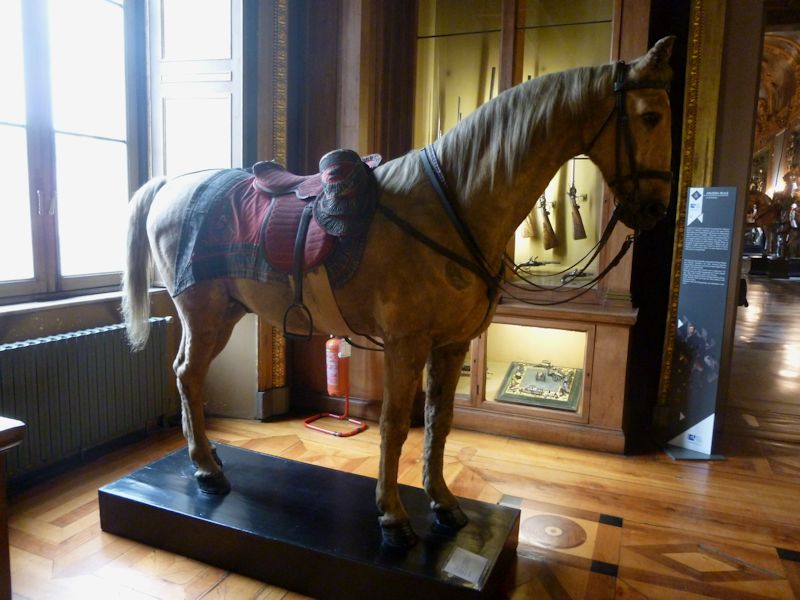You may not find this terribly rewarding unless you're included here, so this is a good time for casual and random browsers to turn back before they get too caught up in the sweep and majesty of the proceedings and can't let go.
Some scenes of Novara, eastern Piemonte region

We're staying on the Lago di Viverone for the moment, and this morning we're going about 50km eastward to check out Novara briefly. 25 February 2017.

Scenes along the way

Downtown Novara -- it's a very livable-looking city of about 100,000 (second largest in the Piemonte region, after Torino), with a considerable history and not too many of the historical charms that usually impel us to visit a place in Italy.

Novara was a municipium in Roman times, situated on the important road between Vercelli and Milan (Mediolanum), and it's still laid out on its original Roman grid plan. The city is still a geographical centre, near the junction of the autostrade connecting Torino with Milan and Venice, west to east, and Genoa with Vercelli then Stresa and Gravellone Toce leading to the Simplon Pass over to Switzerland to the north.

The city walls were all knocked down to permit urban expansion, replaced by a ring of broad boulevards, but the gatehouses are memorialized by these twin facing customs houses, the 'Albertina Barrier', built in 1836 to replace the city gatehouse on the Torino-Milan road. It was meant to honor Charles Albert "the Hesitant", the semi-reformist King of Sardinia (which ruled the Piemonte as successor to the old kingdom of Savoy), who abdicated in 1849 after losing very badly the Battle of Novara to the authoritarian Austrian-Hungarian army under Marshal Radetzky.

We're proceeding up the Corso Italia, the old east-west "decumanus maximus" on the Roman city grid axis, but it's getting boring so . . .

. . . we slip southward through this mini-mall, with sadly several empty shops, to emerge onto . . .

the Via Fratelli Rosselli, with this carnival balloon vendor becoming disconsolate.

This is the Piazza Martiri della Libertà, with its characteristically overstated equestrian statue of Victor Emmanuel II ('Vittorio Emanuele Maria Alberto Eugenio Ferdinando Tommaso'), his father's successor as King of Sardinia after 1849 and first King of Italy after 1861.

The Teatro Coccia on the eastern side of the piazza

Across the Piazza Martiri della Libertà . . .

. . . with its carpark watched over by the king and his horse

The Piazza Martiri della Libertà was formerly called the Piazza Castello, because of the Castello Visconteo-Sforzesco, the fortifications begun in 1293 and built up by the Milanese under the Visconti and Sforza dukes in the 14th and 15th centuries.

Like most surviving urban castles, it was used as a prison, in this case from 1803 to 1973, and is presently undergoing renovation. In fact, according to the sign of the door, the anno di conclusione dell'intervento di restauro will be in 2015 -- so we have that to look forward to.


Goodbye, Mr Emmanuel II. Mr Emmanuel's horse is made of bronze, but . . .

The southeastern tower of the Castello Visconteo-Sforzesco; perhaps that was the original tower upon which all the rest was elaborated.

The southern side of the fortress, facing the huge urban gardens called the Parco Allea San Luca.

The southern bridge over the moat and its gate -- clearly there are more than just minor repairs going on here.

Novara was destroyed in AD 386, by the usurping Emperor Magnus Maximus, again in 405 by the Goth commander Radagaisus and in 452 by Attila's Huns-led maurauders.

Once rebuilt, Novara became a convenient administrative centre for the Lombards and then the Carolingians, and eventually more or less a Free Imperial City on its own. During the 12th century's Lombard wars with the Holy Roman Empire, Novara became part of the sphere of Milan under first the Visconti and later the Sforzas.

On the left, the Basilica of San Gaudenzio, and on the right the Duomo di Novara. Let's go.

An unpleasant statue of the 18th century Duke of Savoy and King of Sardinia, Charles Emmanuel III, in the Via Puccini near the Duomo

The Carneval season seems to be getting under way, judging from all the balloons. But not everyone seems festive.

The Duomo di Novara, or Cattedrale di Santa Maria Assunta, in the Piazza della Repubblica. Christianity began to infiltrate the pantheon of Celtic gods here in the 4th century, under the influence of St Ambrose of Milan and St Eusebius of Vercelli, and St Gaudenzio is considered to have been the first bishop consecrated here, in 397 or '98.

The original cathedral was consecrated in 1132 but knocked down in the 19th century to clear space for this neo-classical thing in the 1860s. Luckily, it's locked up tight at the moment. The surviving 5th century baptistery is somewhere in there behind the fences.

The Piazza della Repubblica (formerly the Piazza Duomo in the old days) . . .

. . . with entertainment

Across from the Duomo, this is the Monumental Complex of the Broletto -- the old word for facilities for democratic political assembly of the population in republican-era northern Italian cities -- the medieval administrative heart of the city still with the Palazzo del Podestà, Palazzetto of the Paratici family, the Civic Museum and the Gallery of Modern Art, with the City Council chambers.

A memorial to Novara's fallen partisans from World War II (we didn't notice a memorial to the fallen fascists)

In the Broletto complex

Cute friezes across the top. In one of the major battles of the 'Italian Wars', Louis XII's French army besieged Novara in 1513, and an army of Milan's Swiss mercenaries, on their way to relieve the Swiss holding the city, surprised the French and their German mercenaries and completely destroyed their forces. (Swiss units chased retreating French forces all the way to Dijon until they were handsomely paid off to go home.) Maximilian Sforza was restored as Duke of Milan but was generally considered to have been a Swiss puppet, and there were fears that the Swiss were trying to absorb Milan and Lombardy into the Swiss Confederation.

Back out onto the Via Fratelli Rosselli, named for two heroic anti-fascist organizers who were murdered in 1937 by a French fascist gang on Mussolini's orders. (In the classic movie The Goonies, the two thugs are called the 'Fratelli Brothers'.)

Weighing pros and cons of getting an Amy Winehouse tattoo

At the Piazza Matteoti, this is the Palazzo Natta, now the prefecture of the province of Novara, with its clock tower first erected in 1268, the last survivor of the grim 13th century era of competing family defensive towers crowded into this formerly aristocratic quarter of the city. The clock itself was later scavenged from a nearby church.

Checking out the goods. Turning left at the clock tower, we're in the Corso Mazzini, a continuation of the Corso Cavour, which runs along the old Roman 'cardo' north-south main street and meets the Roman 'decumanus maximus' here in the Piazza Giacomo Mazzeoti, the 'heart of the city'.

The remains of an 11th-12th century clock tower at the 'Angolo delle Ore', where the Corso Italia and Corso Cavour meet

The Corso Cavour and festive balloons with no takers

Not even for the roasted chestnuts. What are things coming to?

We're evidently walking in the right direction.

The cupola of the Basilica of San Gaudenzio, 121 metres high

The statue of Christ at the top is a fake.

Gaudenzio's associated bell tower, from the Via Gaudenzio Ferrari (named for a painter from the region in the 16th century)


The belltower was begun in 1743 by the architect Benedetto Alfieri -- who also created important works in Turin, Vercelli, and Asti, as well as the façade of the St-Pierre Cathedral in Geneva -- and completed in 1786 after his death.

The preceding, very ancient basilica on this spot is said to have been knocked down on orders of the Emperor Charles V -- evidently in 1553 the Spanish imperial authorities wanted it demolished as part of a plan to strengthen the city's defenses.

Modern shortcuts

Gaudenzio himself, born in Ivrea, the patron saint of Novara, is said to have been its first Bishop, consecrated in 397 or 398 by St Ambrose of Milan's successor Simplician. Gaudenzio was evidently a powerful preacher, and what may be his best miracle is that after he'd died, his head kept on speaking so that his assistants could record all his best sermons in writing. Like a former-human tape recorder.

After Charles V or somebody knocked down the former basilica, work was begun on this one on the same site in 1577, by an architect called Pellegrino Tibaldi, though the huge dome and façade were only undertaken by the apparently famous Antonelli in 1840 and finalized in 1888.

Hence a certain amount of disharmony in the overall effect

A single nave with elaborate side chapels, and lots of pretty overwhelming decoration

The late 16th century Chapel of the Nativity

The Cappella della Madonna di Loreto

The high altar. Somewhere here we've got a silver urn with San Gaudenzio in it, but we didn't notice that. How soon they forget.

Kristin

This impressive thing was stuck on top of the dome in 1888, where there's now a copy.

The cupola
We're on the road again
Novara was fine, no complaints at all, but we've decided that rather than pursue its artistic and historical delights deeper and deeper, we'd rather go to see Biella.

Roadside attractions off the autostrada

The Las Vegas Palace hotel in Fornace Crocicchio, featuring videolottery, 'slot machines', AND a sala fumatori

Approaching Biella.























































































